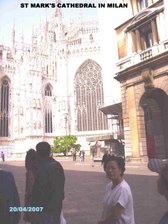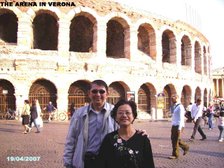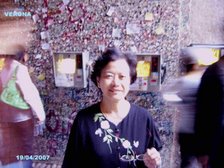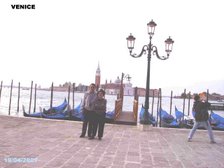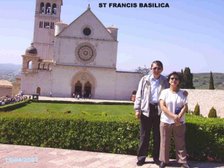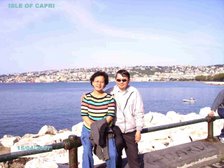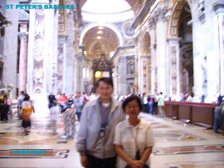OUR TRIP TO ITALY APRIL 2007 - FLORENCE
Next from SIENA we travel to the important city of Florence.
Florence is the capital city of the region of
Tuscany, Italy.
From 1865 to 1870 the city was also the capital of
the Kingdom of Italy. Florence lies on the Arno
River and has a population of around 400,000
people, plus a suburban population in excess of
200,000 persons. The greater area has some
956,000 people. A center of medieval European
trade and finance, the city is often considered the
birthplace of the Italian Renaissance and was long
ruled by the Medici family. Florence is also famous
for its magnificent art and architecture. It is said
that, of the 1,000 most important European artists
of the second millennium, 350 lived or worked in
Florence. The city has also been called the Athens
of the Middle Ages.
The historic Center of Florence was declared a
World Heritage Site by the UNESCO in 1982.
The best-known site and crowning architectural
jewel of Florence is the domed cathedral of the
city, Santa Maria del Fiore, known as The Duomo.
The magnificent dome was built by Filippo
Brunelleschi. The nearby Campanile tower and the Baptistery
buildings are also highlights. Both the dome itself and the
campanile are open to tourists and offer excellent
views.
At the heart of the city in Piazza della Signoria is
Bartolomeo Ammanati's Fountain of Neptune,
which is a masterpiece of marble sculpture at the
terminus of a still functioning Roman aqueduct.
One of the bridges in particular stands out as
being unique — The Ponte Vecchio (Old Bridge),
whose most striking feature is the multitude of
shops built upon its edges, held up by stilts. The
bridge also carried Vasari's elevated corridor
linking the Uffizi to the Medici residence.
First constructed by the Etruscans in
ancient times, this bridge is the only one in the
city to have survived World War II intact.
The San Lorenzo contains the Medici Chapel, the
mausoleum of the Medici family - the most
powerful family in Florence from the 15th to the
18th century. Nearby is the Uffizi Gallery, one of
the finest art galleries in the world - founded on a
large bequest from the last member of the Medici
family.
The Uffizi itself is located on the corner
of Piazza della Signoria, a site important for three
main reasons:
In 1301, Dante was sent into Exile from here (a
plaque on one of the walls of the Uffizi
commemorates the event). In 1497,
it was the location of the Bonfire of the
Vanities (a plaque in the middle of the plaza
commemorates that event), followed in 1498 by
the execution of its instigator, Girolamo
Savonarola In 1504, it was the original location of
Michelangelo's David (now replaced by a
reproduction as the original was moved indoors to
the Accademia dell'Arte del Disegno), in front of
the Palazzo della Signoria (also known as Palazzo
Vecchio). In addition to the Uffizi, Florence has other
world-class museums:
The Bargello concentrates on sculpture,
containing many priceless works of art created by
such sculptors as Donatello, Giambologna, and
Michelangelo.
The Accademia dell'Arte del Disegno (often simply
called the Accademia) collection's highlights are
Michelangelo's David and his unfinished Slaves.
Across the Arno river is the huge Pitti Palace containing
part of the Medici family's former private
collection. In addition to the Medici collection the
palace's galleries contain a large number of
Renaissance works, including several by Raphael
and Titian as well as a large collection of modern
art, costumes, cattiages, and porcerlain. Adjoining
the Palace are the Boboli Gardens, elaborately
landscaped and with many interesting sculptures.
The elaborate Santa Croce church contains the
monumental tombs of Galileo, Michelangelo,
Machiavelli, Dante (actually a cenotaph), and many
other notables.
Other important basilicas in Florence include
Santa Maria Novella, San Lorenzo, Santo Spirito
and the Orsanmichele.
Florence has been the setting for numerous works
of fiction and movies, including the novels and
associated films Hannibal, Tea with Mussolini and
A Room with a View.
Notable residents
Leone Battista Alberti, polymath.
Dante Alighieri, The famous poet & writer
of La Divina Commedia.(Divine Comedy)
Filippo Brunelleschi, famous architect.
Giovanni Boccaccio, famous poet.
Giotto di Bondone, early Trecento painter of the
Arena Chapel in Padua, the Bardi and Peruzzi
chapels in the Basilica di Santa Croce di Firenze,
and many great panel works including the
Ognisanti Madonna .
Michelangelo Buonarroti, a famous sculptor, also
famous for the ceiling of the Sistine Chapel.
Medici Family
Girolamo Mei, historian and humanist
Lorenzo Ghiberti, sculptor
Donatello, sculptor
Raphael, painter.
Leonardo da Vinci, famous for his Mona Lisa and
other paintings, inventions, and scientific
experiments.
Niccolò Machiavelli, famous Renaissance poet and
philosopher
Giorgio Vasari, painter, architect, and historian
Galileo Galilei, Italian physicist, astronomer, and
philosopher.
Vincenzo Galilei Frescobaldi Family, notable bankers and wine
producers
Oriana Fallaci, journalist and author
Florence Nightingale, pioneer of modern nursing,
and a noted statistician.
The number of important authors, painters, sculpters, scientist, politician, architects and nursing legends made Florence a famous city both for its impotance and culture. The Academia museum which holds the original Michaelangelo's David, many original paintings by Raphael, works by Leonardo Da Vinci had to be booked in advance for several months so for mere tourists like us there were no hope of entering.


